LED is a small light source by electron movement through a semiconductor material. The semiconductor families can be incorporated into devices that emit light over much of the visible spectrum with electrical excitation.
LEDs have two connection pins, one long and one short.

For the current to pass and emit light, the long pin must be connected to the positive pole and the short to the negative pole, otherwise current will not pass and it will not emit light.
What is a Light Emitting Diode?
A light-emitting diode (LED), is a light source comprising semiconductor material. Light emission takes place when an electrical current pass through it. LEDs have so many wide ranges of applications.

LEDs are composed of semiconductor material. The diode is made of a material that allows electrons to flow freely through it when a certain voltage is applied. Thereby electrons flow from the negative to the positive electrode, and during this process, emit photons of light.
LEDs are much more efficient than incandescent (traditional) bulbs and last longer. LEDs are also much stronger, and more durable than traditional light bulbs, and can be used in various applications.
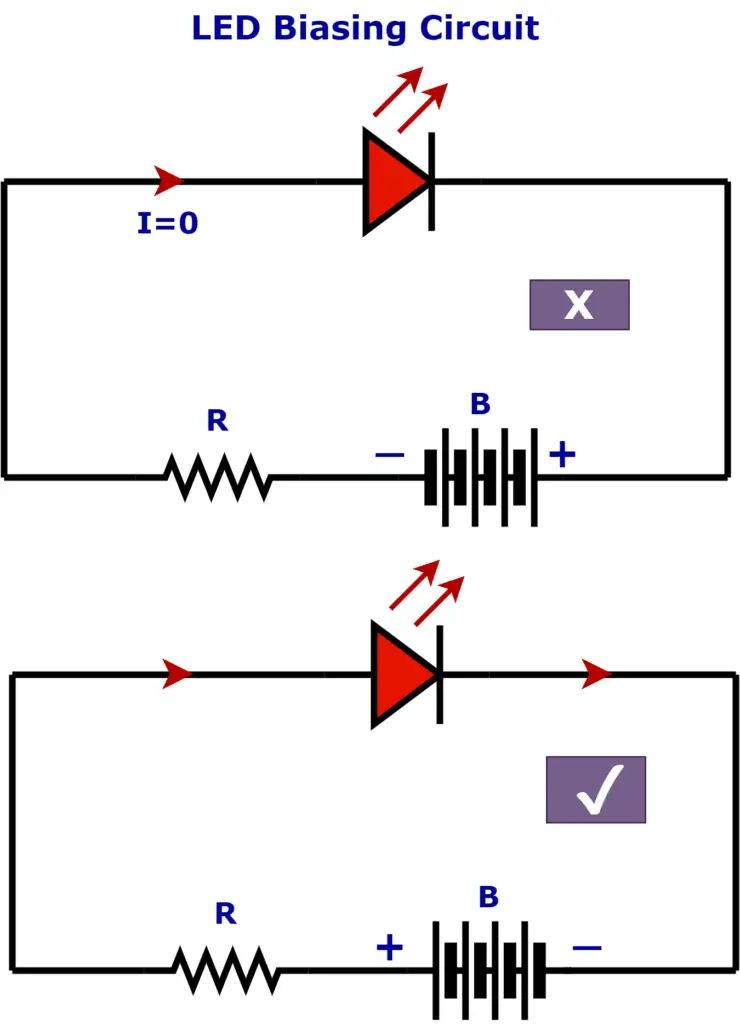
Working Principle of LED
The working principle of LEDs is electroluminescence. They produce light at forward voltages between 1.8 and 3.6 Volts. The anode (positive electrode) is connected to the positive terminal of the DC source, and the cathode (negative electrode) is connected to the ground.
When a current is passed through the diode, electrons flow from the anode to the cathode. The electrons recombine with holes (positive charges) at the junction between the two electrodes. Photons are formed when electrons combine with holes and release energy in the form of light.
LED Symbol

Parts of a common LED

- Epoxy resin encapsulation
- Cable connecting the poles
- Reflective cup
- Semiconductor material
- Internal separation support
- Internal terminal support
- Flat base (identifies the negative terminal or cathode)
- Connection terminal (cathode or negative terminal)
- Connection terminal (anode or positive terminal)
Why does an LED emit light?
An LED emits light because it is made of a material that allows electrons to flow freely through it. When an electrical current is applied to an LED, electrons flow through the material, releasing energy in the form of light.
History
In the year, 1907 – Henry Joseph Round discovers that inorganic materials can ignite when an electric current is applied. In the same year, he publishes his research in the magazine “Mundo Electric”.
1935 – Russian physicist Olega Vladimirovich Losev creates the first LED. His research activity is published in Russian, German, and British journals.
1962 – Launch on the market of the first red luminescent diode. Developed by American Nick Holonyak. The first LED in the range of visible wavelength marked the birth of industrially produced LED.
1971 – LEDs are produced in new colors: green, orange, and yellow as a result of the development of new semiconductor materials. LED performance and efficacy continue to improve.
1993 – The Japanese Shuji Nakamura develops the first blue LED and a very efficient LED in the green lux spectrum (InGaN diode)
1995 – The first white LED derived from luminescence conversion is presented and launched two years later.
1995 – The first light-emitting diodes with 100 lumens/watt are produced. This efficiency can be surpassed only by gas discharge lamps.
2014 – Akasaki, Amano, and Nakamura win the Nobel Prize in Physics for discovering two methods for constructing blue LEDs using a material known as gallium nitride (GaN).
LED operation
The LED emits light when its anode and cathode are connected to positive and negative terminals of the DC supply respectively. In this condition, the LED becomes forward-biased and emits light. The flow of electrons and holes in the forward biasing of LED is shown in the below picture.
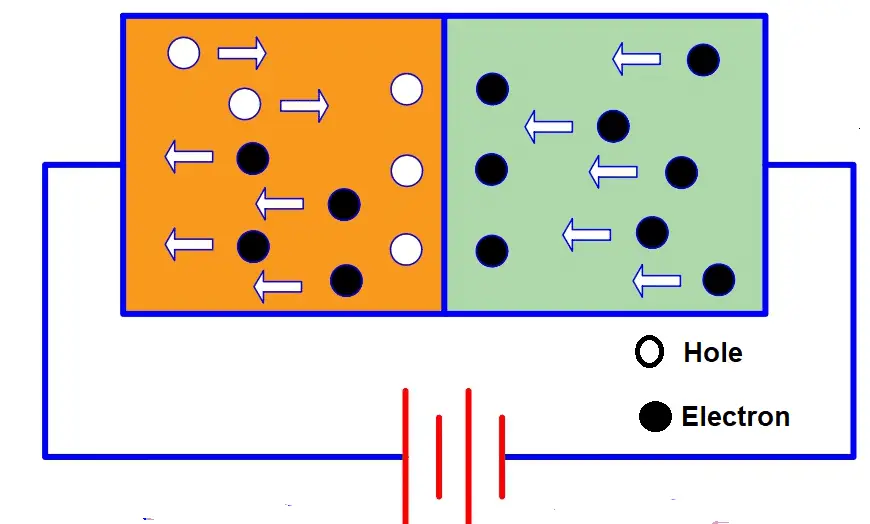
The free electrons in the conduction band present in the N zone are attracted by the higher concentration of holes and positive charges that are in the P zone of the semiconductor and the positive pole of the battery, upon reaching the N-P junction zone, they recombine with existing atoms in the P zone, that is they occupy the available holes.

The further away from the nucleus an electron has the more energy, the free electrons that are not in the orbits of the atoms have a higher energy.
When these electrons enter the atom occupying a hole in the last orbit or valence shell, that excess energy that is left over is released in the form of photons, which are the particles of which light is made.
In this junction zone between the N and P zones, a potential barrier is formed as in the case of junction diodes but in this case larger, and depending on the type it ranges between 1.6 V and 3.6 V.
Depending on the energy they release, one color or another is emitted depending on the material used in its construction.
Construction of Light Emitting Diode
LEDs emit light when an electrical current is passed through them. The material used to make an LED can be organic or inorganic. The most common type of LED is made from inorganic materials, such as gallium arsenide (GaAs) or silicon carbide (SiC).
LED Direct Current
LEDs are very sensitive devices and the amount of current that flows through an LED is very important. The brightness of an LED varies depending on the amount of current they draw.
Light-emitting diodes (LEDs) are designed to withstand maximum forward current without burning out. Allowing the current to be higher than the rated current will burn out the LED.
For example, the most commonly used 5 mm LEDs have a current rating ranging from 20 mA to 30 mA. Whereas 8 mm LEDs have a current rating of 150 mA (for exact information, check the datasheet).
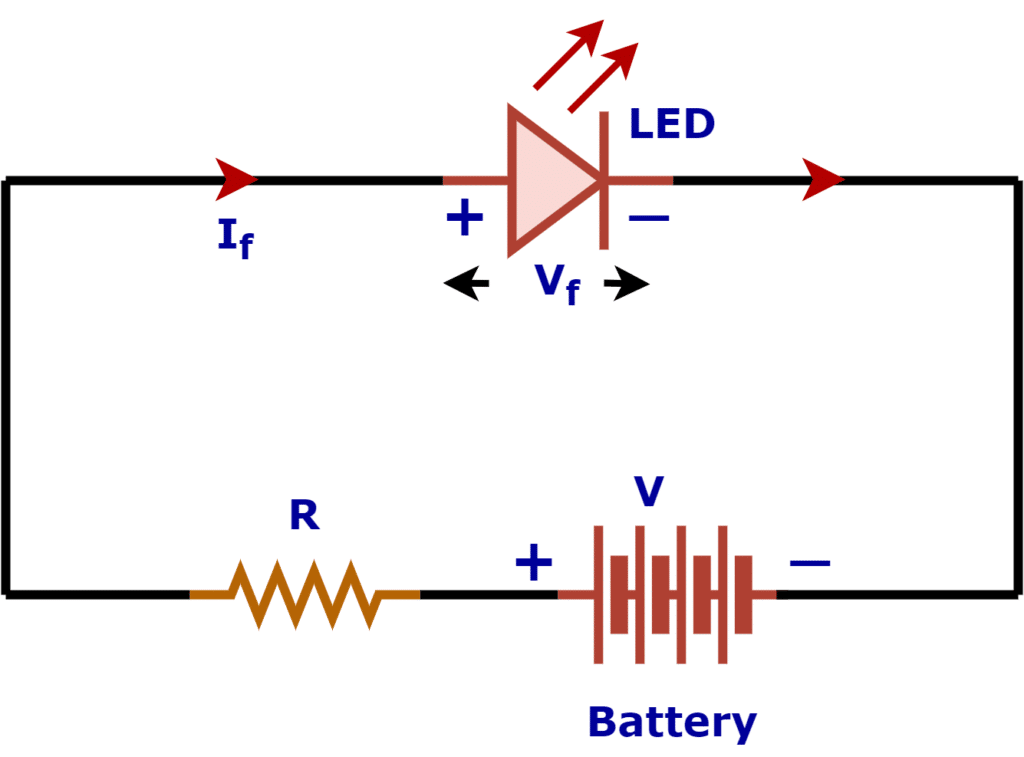
As shown in the above (LED biasing circuit) figure, we use a current-limiting resistor R in series to control the current flowing through an LED.
The value of the series resistance can be calculated using the following formula.

where,
Vf= Applied Voltage
V=Voltage Drop across LED
If = Current through LED
For Example, If If= 20mA, Vf= 1.8 Volts, V=5 Volts,then
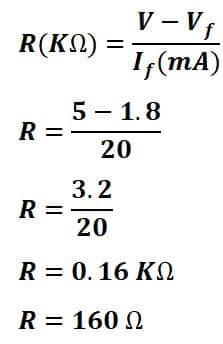
Bicolour LEDs
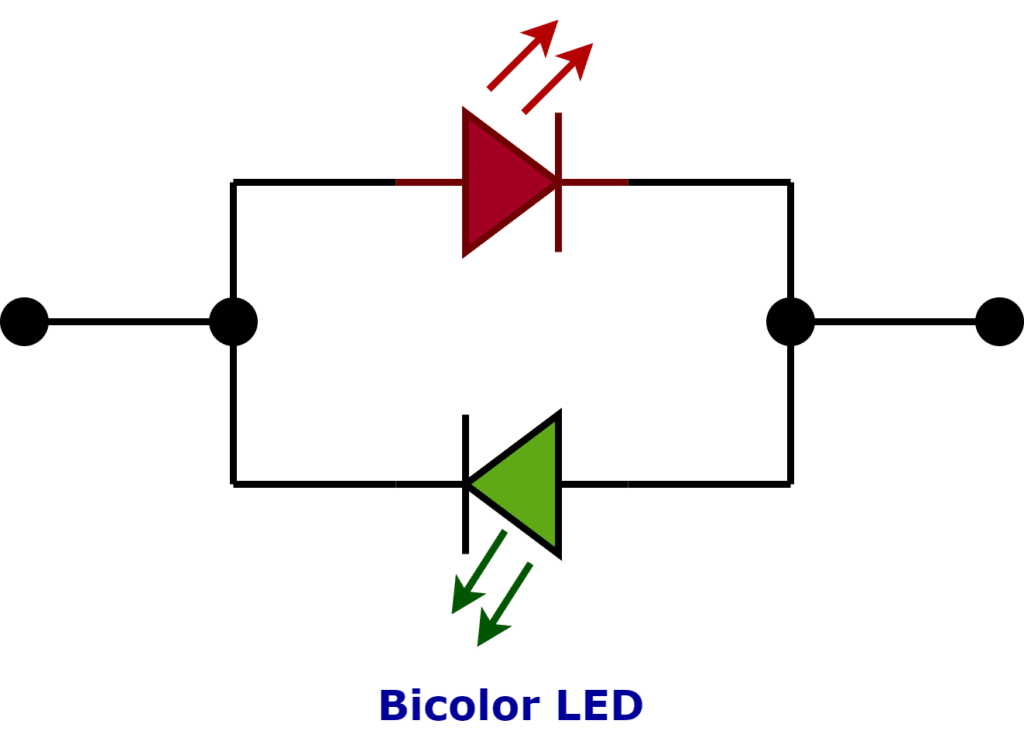
A bicolor LED is one in which there are, in a single encapsulation, two LEDs connected in “inverse parallel” (one forward and one backward).
Bicolour LEDs can emit, for example, red when the device is connected in one direction and green when it is driving in the other direction.
This kind of bi-directional arrangement is useful for indicating polarity. Example: correct connection of batteries or power supplies, etc.,
RGB LEDs
This component is widely used in advertising panels where arrays of hundreds or thousands of them are present.
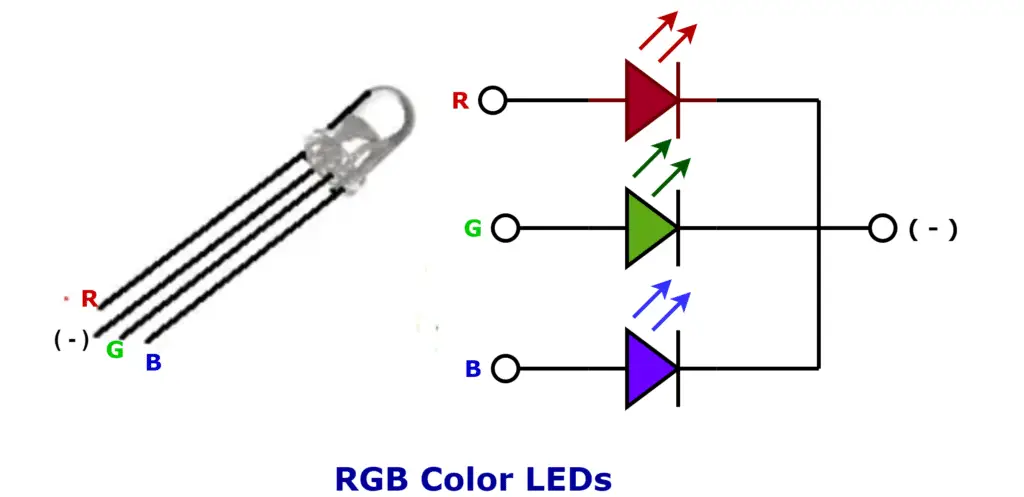
The main advantage over other LEDs is that they can reproduce almost any color perfectly. They can be used in media where images and videos are shown, or to illuminate an area of a certain color.
Classification of LEDs
Classification of LEDs on the market, based on the semiconductor material
- Gallium Arsenide (GaAs) – Infrared light.
- Gallium Arsenide Phosphide (GaAsP) – Red-infrared, orange.
- Aluminium Gallium Arsenide Phosphide (AIGaAsP) – high gloss red, orange-red, orange, and yellow.
- Gallium Phosphide (GaP) – (three colors) Red, Yellow, and Green.
- Aluminum Gallium Phosphide (AlGaP) – Green.
- Gallium Nitride (GaN) – Green, Emerald Green.
- Gallium Indium Nitride (GaInN) – Near ultraviolet, teal, and blue.
- Silicon Carbide (SiC) – Blue.
- Zinc Selenide (ZnSe) – Blue.
- Aluminum Gallium Nitride (AlGaN) – Ultraviolet.
- Most light-emitting diodes (LEDs) require an operating voltage (in forward bias) of approximately 1.2 to 3.6 V. Current rating ranges from about 10 to 30 mA, with 12 to 20 mA being the most common.
Advantages of LEDs
Compared to conventional incandescent or fluorescent light sources, LEDs offer many advantages
- LED light sources consume lower power, also comfort.
- Longer lifespan (up to 50,000 hours).
- Free of mercury and other harmful toxic materials.
- High luminous efficacy.
- LEDs do not emit heat, or they require heat for their operation.
- No switching-ON delays.
- Improved physical robustness.
- Smaller size.
- Lighting adjusts to our needs, both in quantity and intensity. There is the possibility that they are dimmable.
- Ability to be manufactured in many different forms.
- The visible spectrum’s colors are much more defined and controlled.
- In the case of multi-colored LEDs, with a fast-switching frequency.
Disadvantages of LEDs
- Higher price than traditional bulbs.
- They are not as powerful as, for example, halogens.
- The biggest enemy of these lamps is the temperature of 65 Deg C.
Applications
- Among the most popular is the backlighting of TV, computer screens, and mobile devices.
- They are used in quantum computing, electronic devices, or lighting in mining industries.
- Used in the navigation light of airplanes, and the headlights of vehicles.
- Car and motorcycle lights.
- Traffic lights and traffic signals.
- Bioengineering, Medical, and health applications.
- LED lamps for home lighting are as cheap. Very cheaper than compact fluorescent lamps (CFL) with similar nature as LEDs.
- Light bulbs.
- Remote controls or remote controls.
- Indoor and outdoor lighting
- Decoration lamps.
- Lanterns.
- Lamps of sparkles and luminous wallpapers.
- Information and adverting panels.